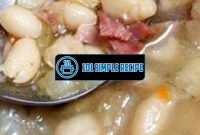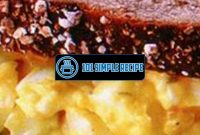If you’re a fan of Gordon Ramsay’s fiery, high-pressure cooking atmosphere, then you must have heard of the infamous Beef Wellington served in Hell’s Kitchen. ️ This classic British dish has become a symbol of culinary excellence and precision, known for its succulent beef fillet encased in a rich mushroom duxelles and luxurious puff pastry. Mastering the art of making Hell’s Kitchen Beef Wellington at home may seem like a daunting challenge, but fear not! In this article, we will guide you through the step-by-step process, providing expert tips and tricks along the way. So put on your apron, sharpen your knives, and get ready to impress your dinner guests with this delectable masterpiece.

History of Hell’s Kitchen Beef Wellington
Uncover the origins of the iconic Hell’s Kitchen Beef Wellington dish and its rise to culinary stardom.
The Creation of Beef Wellington
The history of Beef Wellington can be traced back to the early 19th century. The dish is believed to have originated in England, although there is some debate around its exact origins. One popular theory suggests that it was named after Arthur Wellesley, the Duke of Wellington, who is said to have been fond of a similar dish made with veal. However, there is no conclusive evidence to support this claim.
Beef Wellington is traditionally made with beef tenderloin that is coated with a layer of pâté and duxelles (a mixture of finely chopped mushrooms, onions, and herbs). The meat is then wrapped in puff pastry and baked until golden brown. The result is a decadent and flavorful dish that combines the richness of the beef with the earthy flavors of the mushrooms and herbs.
Evolving from a simple dish to a culinary masterpiece, Beef Wellington has become synonymous with luxury and indulgence.
Celebrity Chef Gordon Ramsay’s Take on Beef Wellington
One name that is often associated with Beef Wellington is celebrity chef Gordon Ramsay. Ramsay’s version of the dish has gained widespread popularity and has even been featured on his television show, “Hell’s Kitchen.”
Ramsay’s take on Beef Wellington includes a few twists that set it apart from the traditional recipe.
- First, he sears the beef before wrapping it in the puff pastry. This not only adds a beautiful caramelized crust to the meat but also helps to seal in the juices, resulting in a more tender and flavorful final product.
- Second, Ramsay uses a mixture of cremini and porcini mushrooms for the duxelles. The combination of these two types of mushrooms adds depth and richness to the dish.
- Finally, he finishes the Beef Wellington with a red wine sauce. The sauce adds an extra layer of flavor and complements the richness of the beef and mushrooms perfectly.
This modern twist on a classic dish has made Beef Wellington even more popular among food enthusiasts.
Popularity of Beef Wellington in Hell’s Kitchen
In the culinary world, Hell’s Kitchen is renowned for its high standards and demanding clientele. It is no surprise then that Beef Wellington has become a staple dish in the kitchens of Hell’s Kitchen restaurants.
The popularity of Beef Wellington in Hell’s Kitchen can be attributed to its luxurious and indulgent nature. The dish showcases the culinary expertise of the chefs and offers a delightful combination of flavors and textures.
Visitors to Hell’s Kitchen can experience the artistry and skill that goes into creating a perfect Beef Wellington. The dish has become a signature item on many of the restaurants’ menus, and diners flock to enjoy this classic delicacy.
With its rich history and delightful flavors, Hell’s Kitchen Beef Wellington continues to captivate and satisfy the palates of food enthusiasts around the world.
For a refreshing beverage to pair with your Hells Kitchen beef wellington, try our punch bowl recipe. This fruity and flavorful punch is a crowd-pleaser and will add a festive touch to any dinner party.
The Perfect Cut of Beef for Beef Wellington
When it comes to creating the ultimate Beef Wellington, choosing the right cut of beef is of utmost importance. The perfect cut will ensure that your dish is not only tender and juicy but also packed with flavor. Let’s explore some of the best types of beef cuts you can use to achieve the culinary masterpiece that is Hell’s Kitchen Beef Wellington.
Filet Mignon: The Prime Choice
Filet Mignon, also known as the “king of steaks,” is the prime choice for making Beef Wellington. This tenderloin cut comes from the smaller end of the beef tenderloin and is exceptionally tender. Its melt-in-your-mouth texture is a perfect match for the buttery puff pastry and rich duxelles filling. By using Filet Mignon, you are guaranteed a luxurious Beef Wellington experience.
Tip: If you want to take your Beef Wellington to the next level of indulgence, opt for aged Filet Mignon. The aging process enhances its tenderness and deepens its flavor profile even further.
Ribeye: An Alternative for Bold Flavors
If you’re looking to add some bolder flavors to your Beef Wellington, consider using Ribeye. This marbled cut of beef provides a rich and intense taste that complements the other ingredients. While it may not be as tender as Filet Mignon, the Ribeye brings a robust meaty flavor that can satisfy even the most discerning palates.
Tip: To ensure tenderness when using Ribeye, make sure to remove the excess fat before wrapping it in puff pastry. This will help prevent any grease from saturating the pastry and affecting its texture.
Other Cuts to Consider
While Filet Mignon and Ribeye are the top choices for Beef Wellington, there are other cuts that you can consider depending on your preferences and availability. Here are a few alternatives:
- Top Sirloin: This lean and flavorful cut offers a more affordable option without compromising on taste.
- Beef Tenderloin: Similar to Filet Mignon, beef tenderloin provides tenderness and a mild flavor profile that pairs well with the other ingredients.
- Sirloin Tip: If you prefer a leaner cut, the sirloin tip can be a good choice. Just make sure to cook it carefully to avoid it becoming dry.
Note: Whatever cut of beef you choose, remember that the key to a successful Beef Wellington lies not only in the quality of the meat but also in the preparation and cooking techniques.
Now that you know the best cuts of beef to use for your Beef Wellington, you can confidently embark on mastering this culinary art. Whether you opt for the luxurious Filet Mignon or the bold flavors of Ribeye, the result will be a showstopping dish that will leave your guests impressed.
Preparing the Beef
Master the art of preparing the beef to ensure a succulent and evenly cooked centerpiece for your Beef Wellington.
Seasoning the Beef
Before you begin the process of making a delicious Hell’s Kitchen Beef Wellington, it’s crucial to season the beef properly. Seasoning the beef not only enhances its flavor, but also adds depth to the overall dish. To season the beef, you can use a combination of salt, freshly ground black pepper, and any additional spices or herbs you prefer. ️
Start by generously sprinkling the seasoning mixture on both sides of the beef. Make sure to coat the entire surface of the meat evenly. This will ensure that every bite of your Beef Wellington is packed with flavor. The seasoning will also help to tenderize the meat, making it more enjoyable to eat.
Searing the Beef
Once you’ve seasoned the beef, the next crucial step is to sear it. Searing helps to lock in the juices and create a delicious caramelized crust on the outside of the meat. To sear the beef, heat a skillet or frying pan over high heat and add a small amount of oil.
When the oil is hot, carefully place the seasoned beef in the pan. Allow it to cook undisturbed for a few minutes until a golden-brown crust forms. Then, using tongs, flip the beef and sear the other side. This process should only take a few minutes on each side. Searing the beef not only adds flavor but also helps to create a barrier that prevents the juices from seeping out while cooking. This will result in a tender and juicy beef Wellington.
Laying the Foundation with Prosciutto and Duxelles
Now that you have prepared and seared the beef, it’s time to lay the foundation for your Beef Wellington. This is where the prosciutto and duxelles come into play. Prosciutto adds a rich and salty flavor, while duxelles, a mixture of finely chopped mushrooms, garlic, and herbs, adds an earthy and aromatic element to the dish.
To create the foundation, lay out a layer of prosciutto slices on a sheet of plastic wrap, slightly overlapping each other. Then spread a thin layer of duxelles on top of the prosciutto. The thickness of the prosciutto and duxelles layer should be enough to cover the entire surface of the beef.
Once you have evenly spread the prosciutto and duxelles, place the seared beef on top. Gently roll the beef, using the plastic wrap as a guide, until it is completely wrapped in the prosciutto and duxelles layer. Make sure to secure the ends tightly, so the filling doesn’t spill out during cooking. This layer not only adds flavor but also acts as a barrier, keeping the beef moist during the cooking process.
By mastering the art of preparing the beef, seasoning it to perfection, searing it for a mouthwatering crust, and laying the foundation with prosciutto and duxelles, you are well on your way to creating a delectable Hell’s Kitchen Beef Wellington. Each step plays a crucial role in creating a succulent and evenly cooked centerpiece. So, gather your ingredients, sharpen your knives, and embark on a culinary adventure that will surely impress your family and friends. ️
If you’re looking for more delicious recipes, you might also enjoy our Hells Kitchen beef wellington recipe. This recipe is a classic and will definitely impress your guests at your next dinner party.
Wrapping the Beef Wellington
To create the masterpiece that is Hell’s Kitchen Beef Wellington, you must first learn the intricate process of wrapping the beef in puff pastry. This step is crucial in achieving the visually stunning final dish that will leave your guests in awe. So, let’s dive into the step-by-step guide and master the art of enveloping the beef in puff pastry.
Choosing the Right Puff Pastry
Before you start wrapping the beef, it’s important to choose the right puff pastry. The quality of the pastry will greatly affect the taste and texture of your Beef Wellington. Opt for a high-quality, all-butter puff pastry, as it will provide a rich and flaky crust that perfectly complements the tender beef.
You can either make the puff pastry from scratch or purchase pre-made puff pastry from a reliable brand. If you decide to make your own, make sure to follow a trusted recipe and give yourself enough time to properly prepare the pastry. However, if you’re short on time, store-bought puff pastry will work just fine.
Assembling the Beef Wellington
Now that you’ve got the perfect puff pastry, it’s time to assemble the Beef Wellington. Begin by searing the beef fillet in a hot pan until it’s browned on all sides. This will not only add a beautiful caramelized crust but also seal in the juices, ensuring a moist and flavorful final result.
Once the beef is seared, allow it to cool slightly before placing it in the center of your puff pastry. Carefully wrap the beef with the pastry, making sure to seal the edges tightly. You can brush the pastry with beaten egg to create a shiny golden finish when baked.
Remember to take your time during this step and handle the puff pastry with care. Any tears or gaps in the pastry may cause the beef to dry out or lose its juiciness.
Creating a Beautiful Crust
The final touch in mastering the art of making Hell’s Kitchen Beef Wellington is creating a beautiful crust. To achieve this, you’ll need to score the pastry lightly with a knife, creating a decorative pattern. Be careful not to cut too deep, as it may affect the cooking process.
You can also add some extra flair by garnishing the pastry with herbs like thyme or rosemary. These will not only enhance the flavors but also add a pop of color to your dish.
Once your Beef Wellington is assembled and adorned with its decorative crust, it’s ready to be baked to perfection. Follow the cooking instructions carefully, ensuring that the pastry turns golden brown and the beef reaches the desired level of doneness.
Mastering the art of making Hell’s Kitchen Beef Wellington requires attention to detail and practice. By following these steps and using the right ingredients, you’ll be able to create a visually stunning and delicious dish that will impress even the most discerning palates. So, don your chef’s hat and get ready to wow your guests with your culinary skills!
If you’re interested in more tasty recipes, check out our weight loss recipe collection. These recipes are packed with flavor and nutrition, perfect for anyone looking to shed a few pounds.
Baking and Serving
Discover the secrets to perfectly baking a Beef Wellington and presenting it with finesse to impress your guests.
Temperature and Timing
When it comes to baking a Beef Wellington, temperature and timing are crucial factors to consider. Preheat your oven to 400°F (200°C) to ensure that the pastry cooks evenly and develops a golden brown color. This high temperature allows for the pastry to become crisp while sealing in the succulent flavors of the beef.
Timing is also important when baking your Beef Wellington. It is recommended to bake it for approximately 25-30 minutes to achieve a medium-rare consistency for the beef. However, if you prefer your beef to be cooked to a different level of doneness, adjust the baking time accordingly.
Tip: Keep a close eye on the beef while it bakes to avoid overcooking. Inserting a meat thermometer into the center of the Wellington can help you monitor the internal temperature and achieve your desired level of doneness.
Resting and Slicing the Wellington
Once your Beef Wellington is out of the oven, resist the temptation to slice into it immediately. Allow the Wellington to rest for about 10 minutes before slicing. This resting period allows the meat juices to redistribute and ensures a moist and tender slice.
When it comes to slicing the Wellington, use a sharp chef’s knife to cut through the layers of puff pastry and beef. Aim for even slices to showcase the beautifully cooked meat and reveal the layers of mushroom duxelles and prosciutto inside.
Tip: To keep the slices intact and maintain their presentation, use a gentle sawing motion when cutting through the pastry. Wiping the knife clean between each slice also helps to achieve clean edges.
Garnishing and Sauces
The final step in mastering the art of making Hell’s Kitchen Beef Wellington is the garnishing and sauces. Choose garnishes that complement the flavors of the Wellington, such as fresh herbs like thyme or rosemary. These add a pop of color and freshness to the dish.
When it comes to sauces, a classic red wine reduction or a creamy mushroom sauce are excellent choices to serve alongside the Wellington. These rich and flavorful sauces enhance the taste of the beef and complement the buttery pastry.
Tip: Don’t be afraid to get creative with your garnishes and sauces. Consider adding a sprinkle of sea salt or a drizzle of truffle oil for an extra touch of indulgence.
By paying attention to temperature and timing, allowing the Wellington to rest before slicing, and adding the perfect garnishes and sauces, you will master the art of making Hell’s Kitchen Beef Wellington. Impress your guests with this iconic dish that is both visually stunning and incredibly delicious.
Frequently Asked Questions
Thank you for taking the time to read our article on the Hell’s Kitchen Beef Wellington recipe. If you have any further questions, we’ve compiled a list of FAQs below to help clarify any doubts you may have:
| No. | Questions | Answers |
|---|---|---|
| 1. | What is Beef Wellington? | Beef Wellington is a classic dish that features beef fillet coated with pâté, wrapped in puff pastry, and baked until golden and cooked to perfection. |
| 2. | Where does the name Beef Wellington come from? | The dish is named after Arthur Wellesley, the first Duke of Wellington, who was famous for his love of beef and fine dining. |
| 3. | What is the origin of Beef Wellington? | The exact origin of Beef Wellington is uncertain, but it is believed to have been created in the early 19th century in honor of the Duke of Wellington. |
| 4. | What are some variations of Beef Wellington? | There are several variations of Beef Wellington, including substituting the beef fillet with other meats like salmon or chicken, and adding different ingredients to the filling such as mushrooms or foie gras. |
| 5. | What are some side dishes that pair well with Beef Wellington? | Some popular side dishes to serve with Beef Wellington include roasted potatoes, steamed vegetables, and a fresh green salad. |
| 6. | Can Beef Wellington be prepared in advance? | Yes, you can prepare Beef Wellington in advance by assembling the dish and refrigerating it until ready to bake. This makes it a great option for entertaining guests. |
Thank You for Reading!
We hope you enjoyed learning about the famous Hell’s Kitchen Beef Wellington recipe. If you decide to try making it, we’re confident that you’ll impress your family and friends with this elegant and delicious dish. Remember to visit our website again for more exciting recipes and culinary inspiration. Happy cooking!
Jump to Recipe
Hell’s Kitchen Beef Wellington

Learn how to make the iconic Hell’s Kitchen Beef Wellington recipe with this step-by-step guide. Impress your guests with this elegant and delicious dish.
- 1 beef fillet (approximately 500g)
- 300 g puff pastry
- 100 g pâté
- 1 egg (beaten)
- Salt and pepper to taste
- Preheat your oven to 200°C (400°F) and line a baking sheet with parchment paper.
- Season the beef fillet with salt and pepper. Heat a large skillet over high heat and sear the beef on all sides until browned. Remove from the heat and let it cool.
- Roll out the puff pastry on a lightly floured surface to a rectangular shape large enough to encase the beef fillet. Spread the pâté evenly over the pastry.
- Place the seared beef fillet on top of the pâté-covered pastry. Carefully fold the pastry over the beef, sealing it tightly. Trim any excess pastry and seal the edges by pressing with a fork.
- Brush the pastry with beaten egg for a golden finish. Transfer the Beef Wellington to the prepared baking sheet and bake in the preheated oven for 30-40 minutes, or until the pastry is golden brown and cooked through.
- Let the Beef Wellington rest for a few minutes before slicing it into thick portions. Serve with your favorite side dishes and enjoy!






